Giám sát và đánh giá chất lượng trải nghiệm (QoE) cho ứng dụng web
Cung cấp chất lượng trải nghiệm (Quality of
Experience –QoE) đáp ứng nhu cầu người dùng là yêu
cầu rất quan trọng đối với các nhà cung cấp dịch vụ ứng
dụng Web. Nhiều thách thức đặt ra đối với giám sát và
đánh giá QoE do vẫn chưa có một mô hình phù hợp cho
định lượng QoE. Các nghiên cứu tới nay chủ yếu tập
trung vào cải thiện QoE về các tham số liên quan đến
thời gian, mối quan hệ tương tác giữa QoS và QoE, mối
quan hệ giữa QoE và MOS (Mean Opinion Scores). Tuy
nhiên, vấn đề giám sát QoE theo thời gian thực vẫn chưa
được quan tâm đúng mức. Mặt khác, hầu hết các mô hình
QoE tới nay đều dựa trên các tham số do ITU đề xuất cho
mạng và ứng dụng đa phương tiện, chưa có mô hình cho
ứng dụng Web. Dựa trên cơ sở các tham số theo tiêu
chuẩn của ITU, bài báo này đề xuất một mô hình tham
chiếu cho giám sát và đánh giá QoE cho ứng dụng Web.
Mô hình tham chiếu WebQoE-RefMod có các đặc trưng:
1) Xác định tập hồ sơ tham chiếu để so sánh, đánh giá
QoE, 2) Xác định tập các điểm đo tham chiếu, 3) Tính
giá trị QoE là hàm của các chỉ số KPI và KQI, 4) Giám
sát và đánh giá QoE theo công thức tính thống kê khoảng
cách tới giá trị Ref-QoE.1
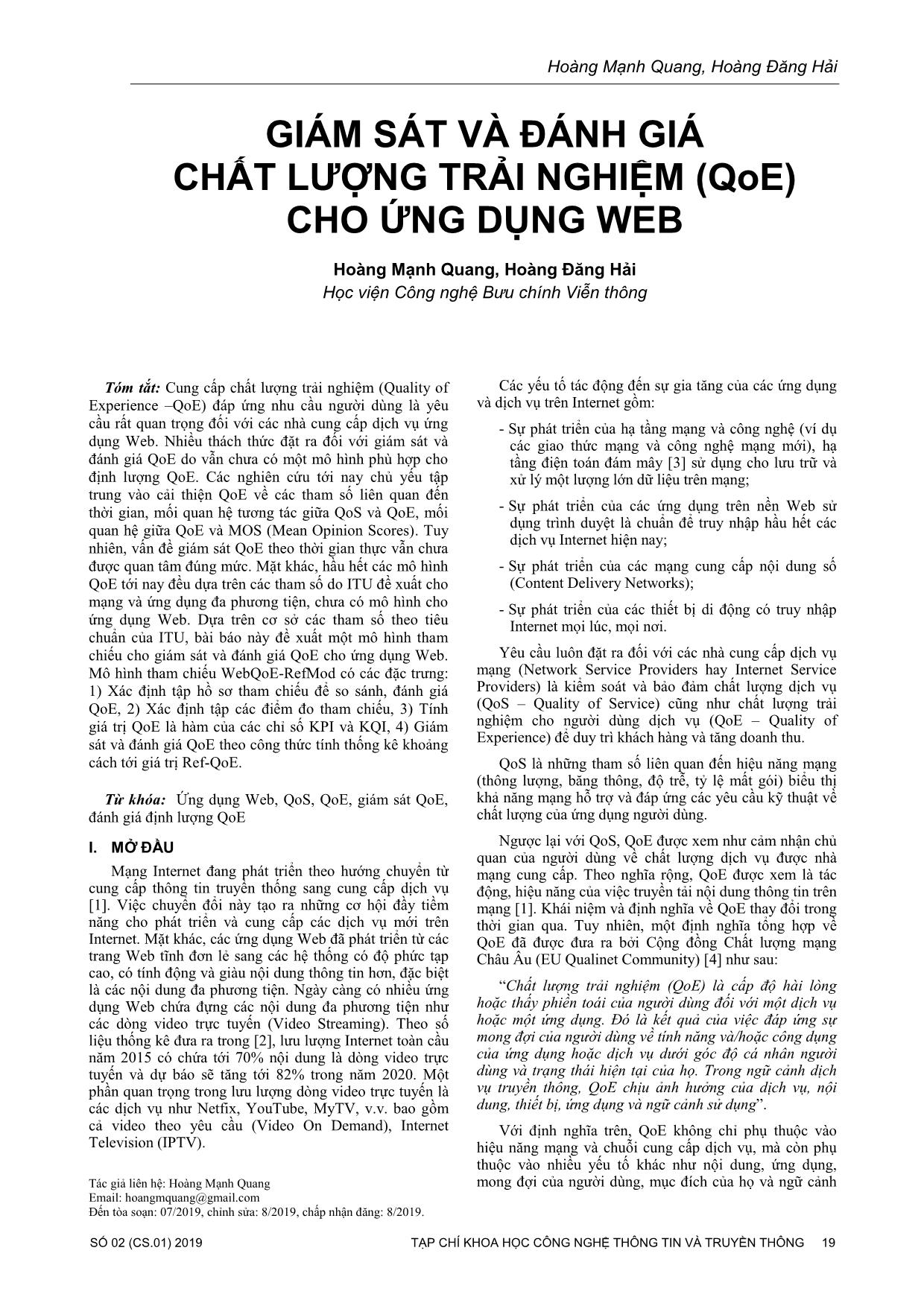
Trang 1
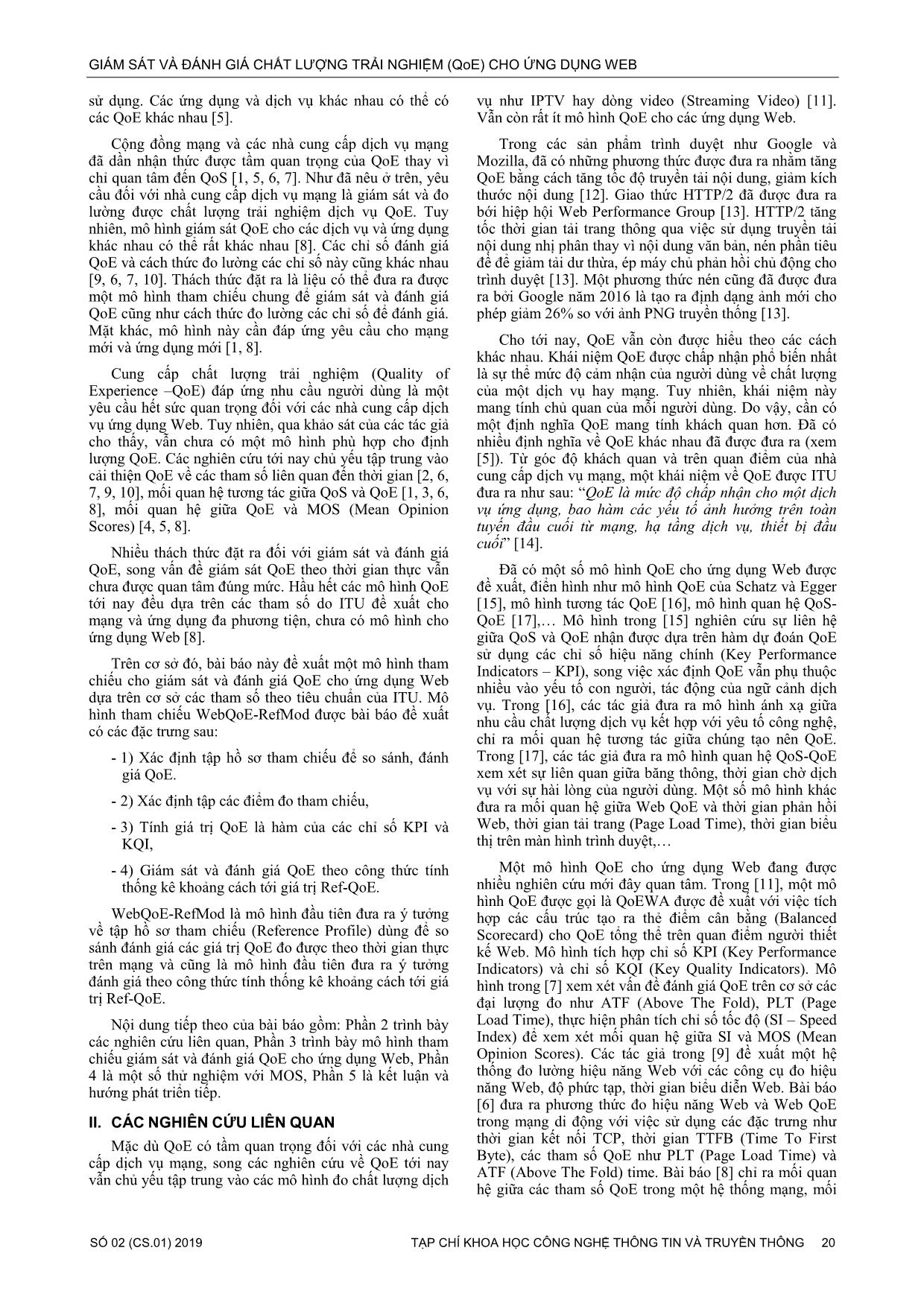
Trang 2
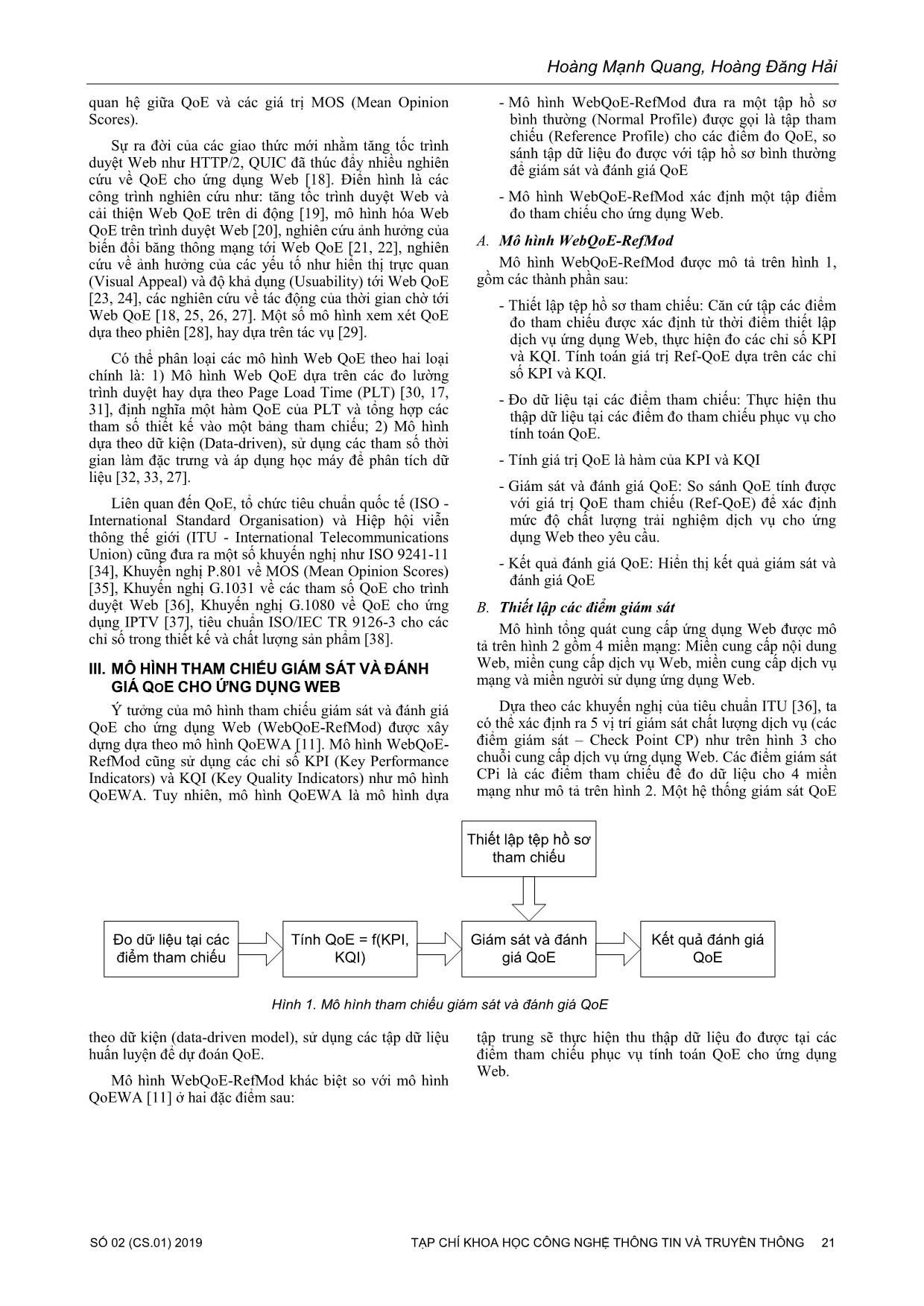
Trang 3
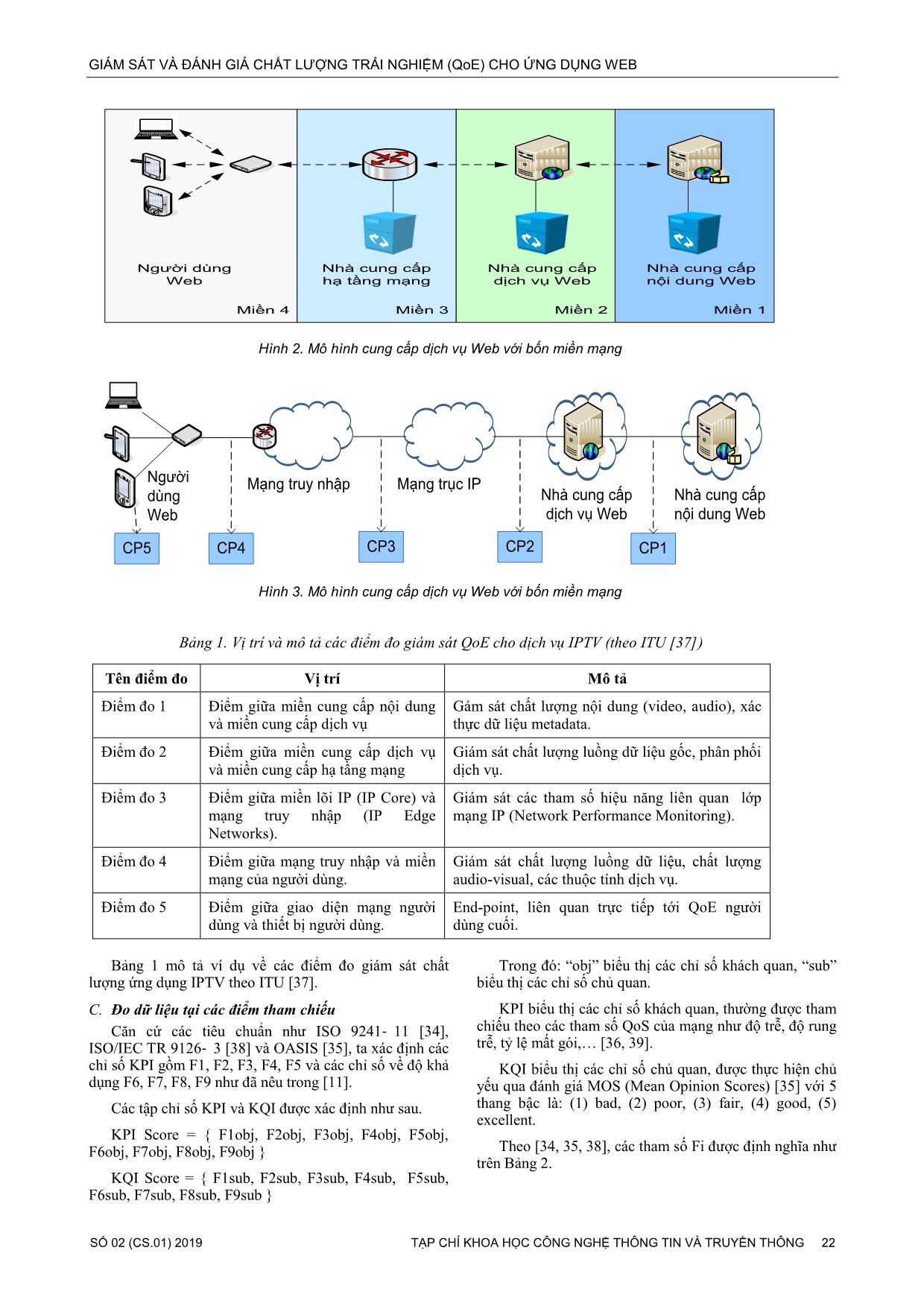
Trang 4
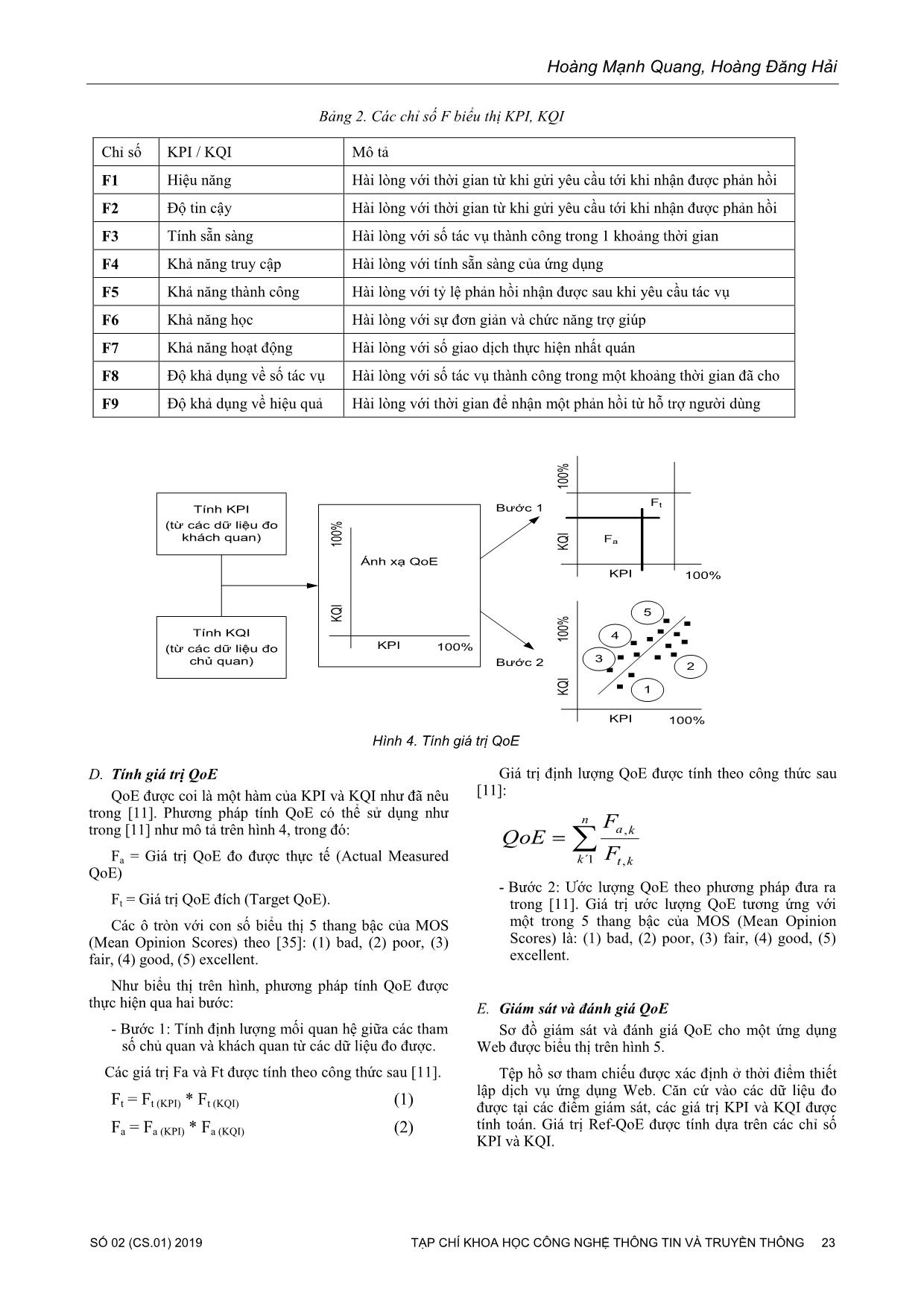
Trang 5
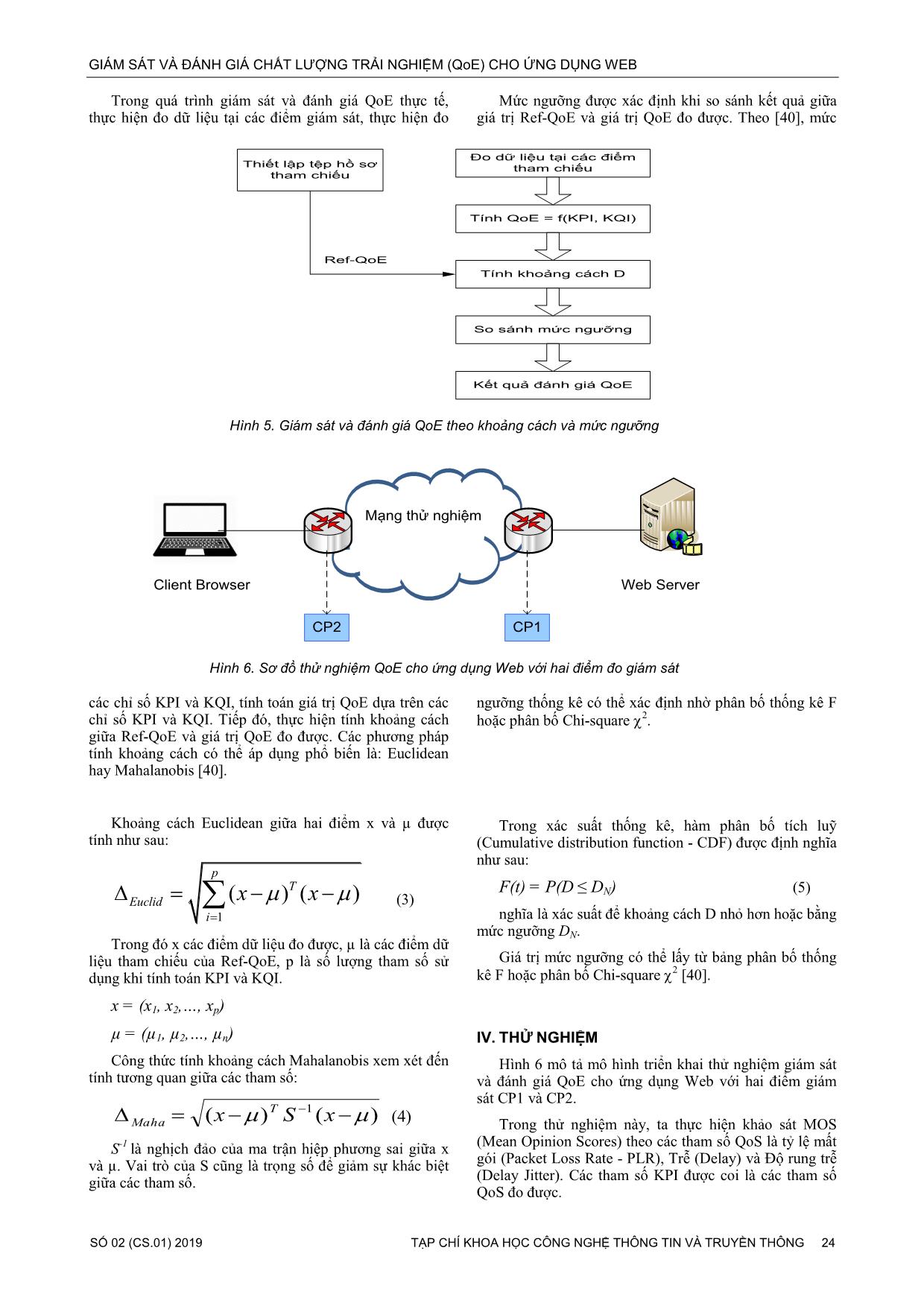
Trang 6
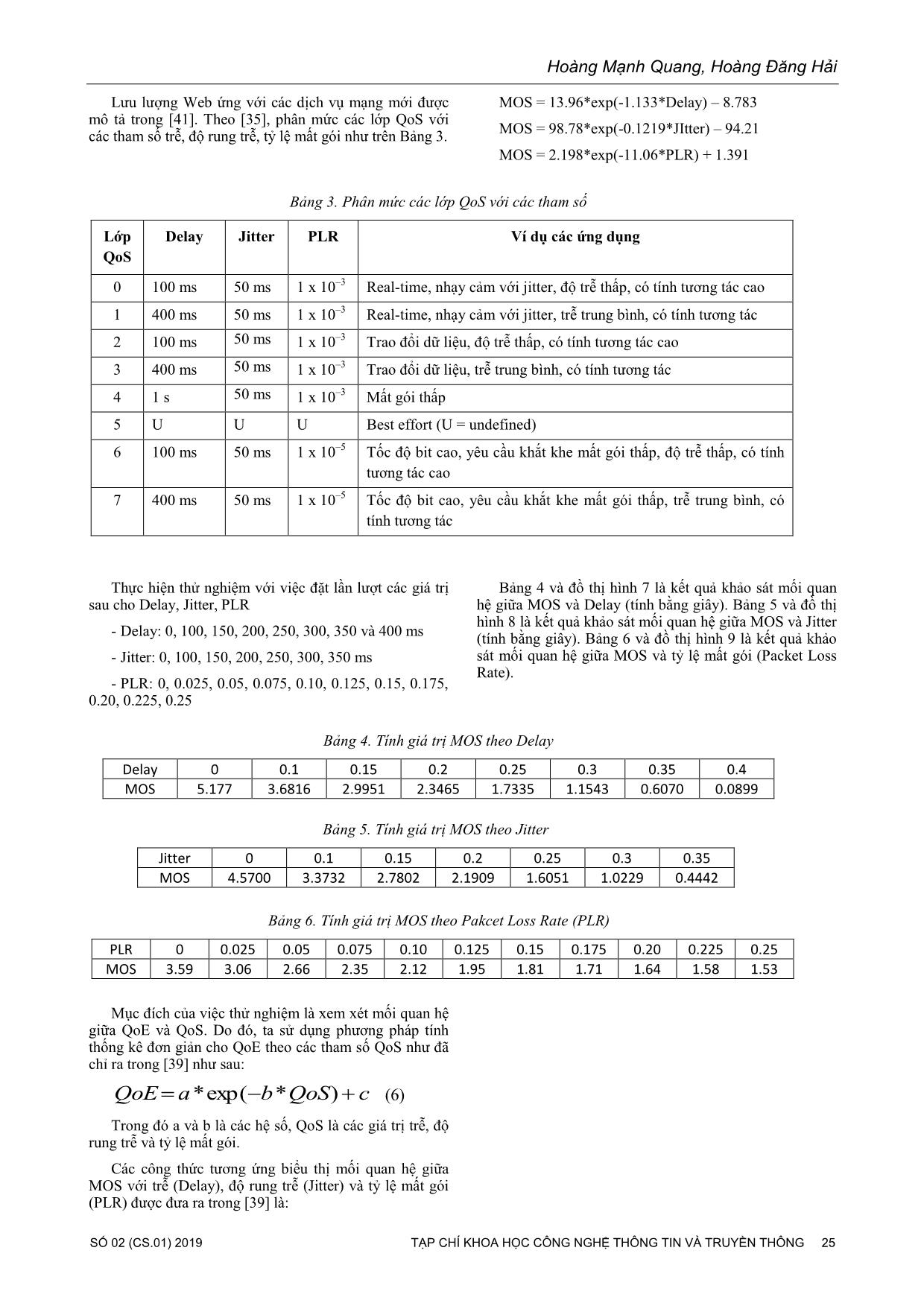
Trang 7
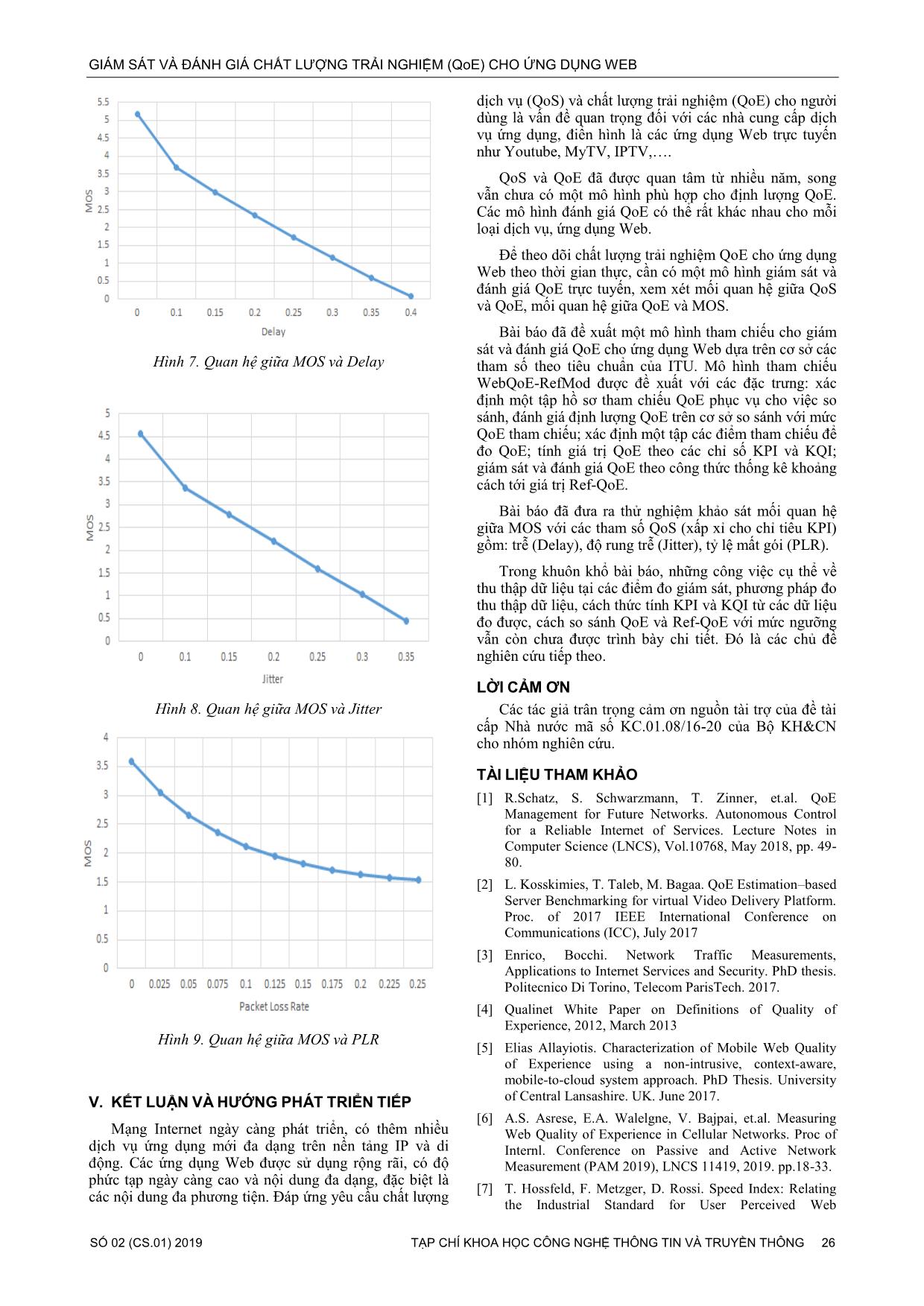
Trang 8
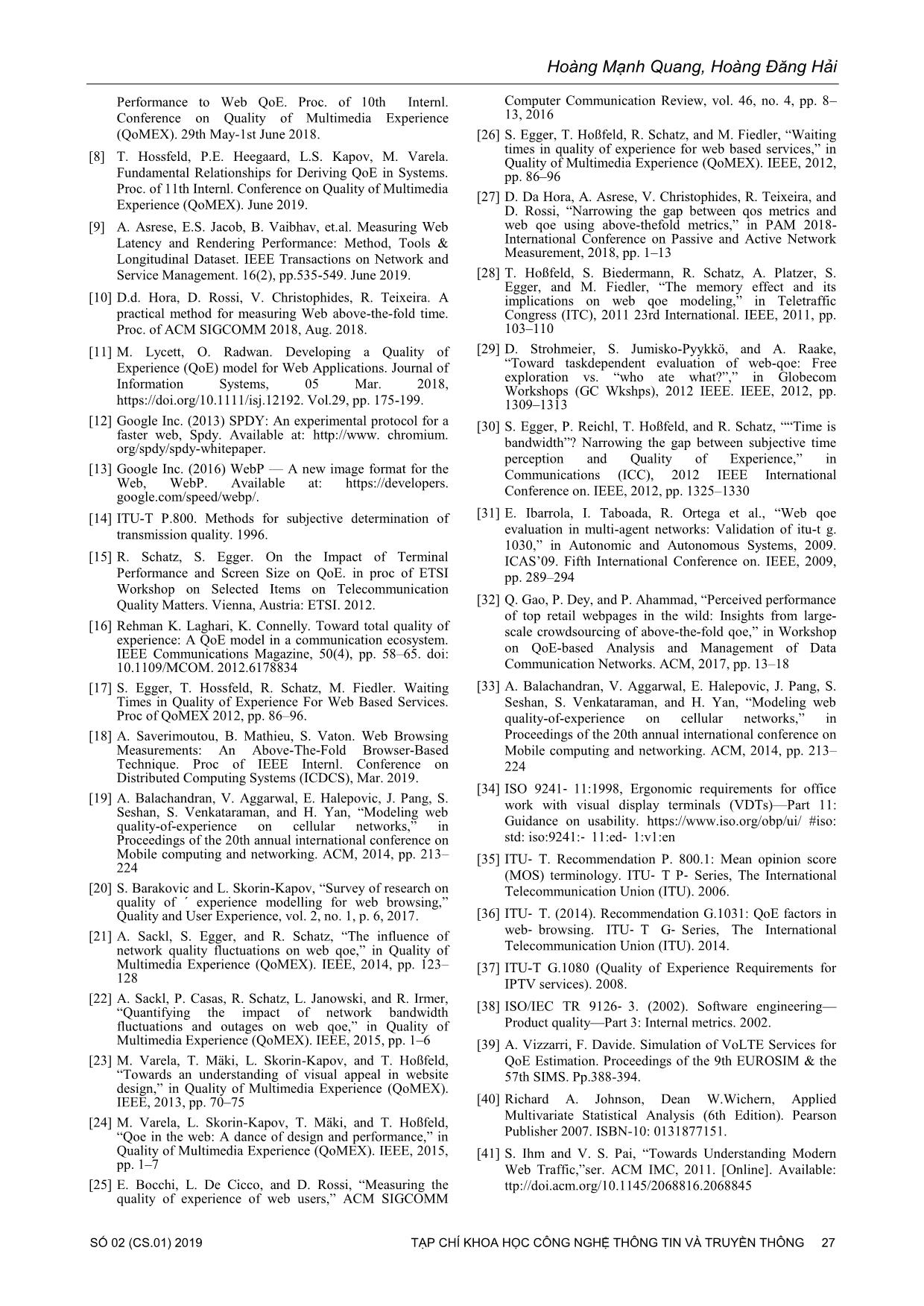
Trang 9

Trang 10
Tóm tắt nội dung tài liệu: Giám sát và đánh giá chất lượng trải nghiệm (QoE) cho ứng dụng web
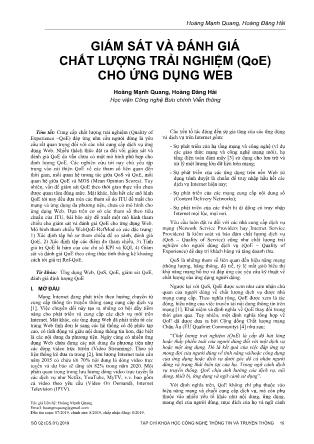
ính QoE = f(KPI, KQI) Tính khoảng cách D So sánh mức ngưỡng Kết quả đánh giá QoE Ref-QoE Hình 5. Giám sát và đánh giá QoE theo khoảng cách và mức ngưỡng Mạng thử nghiệm CP2 CP1 Client Browser Web Server Hình 6. Sơ đồ thử nghiệm QoE cho ứng dụng Web với hai điểm đo giám sát Hoàng Mạnh Quang, Hoàng Đăng Hải Lưu lượng Web ứng với các dịch vụ mạng mới được mô tả trong [41]. Theo [35], phân mức các lớp QoS với các tham số trễ, độ rung trễ, tỷ lệ mất gói như trên Bảng 3. Thực hiện thử nghiệm với việc đặt lần lượt các giá trị sau cho Delay, Jitter, PLR - Delay: 0, 100, 150, 200, 250, 300, 350 và 400 ms - Jitter: 0, 100, 150, 200, 250, 300, 350 ms - PLR: 0, 0.025, 0.05, 0.075, 0.10, 0.125, 0.15, 0.175, 0.20, 0.225, 0.25 Mục đích của việc thử nghiệm là xem xét mối quan hệ giữa QoE và QoS. Do đó, ta sử dụng phương pháp tính thống kê đơn giản cho QoE theo các tham số QoS như đã chỉ ra trong [39] như sau: cQoSbaQoE )*exp(* (6) Trong đó a và b là các hệ số, QoS là các giá trị trễ, độ rung trễ và tỷ lệ mất gói. Các công thức tương ứng biểu thị mối quan hệ giữa MOS với trễ (Delay), độ rung trễ (Jitter) và tỷ lệ mất gói (PLR) được đưa ra trong [39] là: MOS = 13.96*exp(-1.133*Delay) – 8.783 MOS = 98.78*exp(-0.1219*JItter) – 94.21 MOS = 2.198*exp(-11.06*PLR) + 1.391 Bảng 4 và đồ thị hình 7 là kết quả khảo sát mối quan hệ giữa MOS và Delay (tính bằng giây). Bảng 5 và đồ thị hình 8 là kết quả khảo sát mối quan hệ giữa MOS và Jitter (tính bằng giây). Bảng 6 và đồ thị hình 9 là kết quả khảo sát mối quan hệ giữa MOS và tỷ lệ mất gói (Packet Loss Rate). Bảng 3. Phân mức các lớp QoS với các tham số Lớp QoS Delay Jitter PLR Ví dụ các ứng dụng 0 100 ms 50 ms 1 x 10 –3 Real-time, nhạy cảm với jitter, độ trễ thấp, có tính tương tác cao 1 400 ms 50 ms 1 x 10 –3 Real-time, nhạy cảm với jitter, trễ trung bình, có tính tương tác 2 100 ms 50 ms 1 x 10 –3 Trao đổi dữ liệu, độ trễ thấp, có tính tương tác cao 3 400 ms 50 ms 1 x 10 –3 Trao đổi dữ liệu, trễ trung bình, có tính tương tác 4 1 s 50 ms 1 x 10 –3 Mất gói thấp 5 U U U Best effort (U = undefined) 6 100 ms 50 ms 1 x 10 –5 Tốc độ bit cao, yêu cầu khắt khe mất gói thấp, độ trễ thấp, có tính tương tác cao 7 400 ms 50 ms 1 x 10 –5 Tốc độ bit cao, yêu cầu khắt khe mất gói thấp, trễ trung bình, có tính tương tác Bảng 4. Tính giá trị MOS theo Delay Delay 0 0.1 0.15 0.2 0.25 0.3 0.35 0.4 MOS 5.177 3.6816 2.9951 2.3465 1.7335 1.1543 0.6070 0.0899 Bảng 5. Tính giá trị MOS theo Jitter Jitter 0 0.1 0.15 0.2 0.25 0.3 0.35 MOS 4.5700 3.3732 2.7802 2.1909 1.6051 1.0229 0.4442 Bảng 6. Tính giá trị MOS theo Pakcet Loss Rate (PLR) PLR 0 0.025 0.05 0.075 0.10 0.125 0.15 0.175 0.20 0.225 0.25 MOS 3.59 3.06 2.66 2.35 2.12 1.95 1.81 1.71 1.64 1.58 1.53 GIÁM SÁT VÀ ĐÁNH GIÁ CHẤT LƯỢNG TRẢI NGHIỆM (QoE) CHO ỨNG DỤNG WEB Hình 7. Quan hệ giữa MOS và Delay Hình 8. Quan hệ giữa MOS và Jitter Hình 9. Quan hệ giữa MOS và PLR V. KẾT LUẬN VÀ HƯỚNG PHÁT TRIỂN TIẾP Mạng Internet ngày càng phát triển, có thêm nhiều dịch vụ ứng dụng mới đa dạng trên nền tảng IP và di động. Các ứng dụng Web được sử dụng rộng rãi, có độ phức tạp ngày càng cao và nội dung đa dạng, đặc biệt là các nội dung đa phương tiện. Đáp ứng yêu cầu chất lượng dịch vụ (QoS) và chất lượng trải nghiệm (QoE) cho người dùng là vấn đề quan trọng đối với các nhà cung cấp dịch vụ ứng dụng, điển hình là các ứng dụng Web trực tuyến như Youtube, MyTV, IPTV,. QoS và QoE đã được quan tâm từ nhiều năm, song vẫn chưa có một mô hình phù hợp cho định lượng QoE. Các mô hình đánh giá QoE có thể rất khác nhau cho mỗi loại dịch vụ, ứng dụng Web. Để theo dõi chất lượng trải nghiệm QoE cho ứng dụng Web theo thời gian thực, cần có một mô hình giám sát và đánh giá QoE trực tuyến, xem xét mối quan hệ giữa QoS và QoE, mối quan hệ giữa QoE và MOS. Bài báo đã đề xuất một mô hình tham chiếu cho giám sát và đánh giá QoE cho ứng dụng Web dựa trên cơ sở các tham số theo tiêu chuẩn của ITU. Mô hình tham chiếu WebQoE-RefMod được đề xuất với các đặc trưng: xác định một tập hồ sơ tham chiếu QoE phục vụ cho việc so sánh, đánh giá định lượng QoE trên cơ sở so sánh với mức QoE tham chiếu; xác định một tập các điểm tham chiếu để đo QoE; tính giá trị QoE theo các chỉ số KPI và KQI; giám sát và đánh giá QoE theo công thức thống kê khoảng cách tới giá trị Ref-QoE. Bài báo đã đưa ra thử nghiệm khảo sát mối quan hệ giữa MOS với các tham số QoS (xấp xỉ cho chỉ tiêu KPI) gồm: trễ (Delay), độ rung trễ (Jitter), tỷ lệ mất gói (PLR). Trong khuôn khổ bài báo, những công việc cụ thể về thu thập dữ liệu tại các điểm đo giám sát, phương pháp đo thu thập dữ liệu, cách thức tính KPI và KQI từ các dữ liệu đo được, cách so sánh QoE và Ref-QoE với mức ngưỡng vẫn còn chưa được trình bày chi tiết. Đó là các chủ đề nghiên cứu tiếp theo. LỜI CẢM ƠN Các tác giả trân trọng cảm ơn nguồn tài trợ của đề tài cấp Nhà nước mã số KC.01.08/16-20 của Bộ KH&CN cho nhóm nghiên cứu. TÀI LIỆU THAM KHẢO [1] R.Schatz, S. Schwarzmann, T. Zinner, et.al. QoE Management for Future Networks. Autonomous Control for a Reliable Internet of Services. Lecture Notes in Computer Science (LNCS), Vol.10768, May 2018, pp. 49- 80. [2] L. Kosskimies, T. Taleb, M. Bagaa. QoE Estimation–based Server Benchmarking for virtual Video Delivery Platform. Proc. of 2017 IEEE International Conference on Communications (ICC), July 2017 [3] Enrico, Bocchi. Network Traffic Measurements, Applications to Internet Services and Security. PhD thesis. Politecnico Di Torino, Telecom ParisTech. 2017. [4] Qualinet White Paper on Definitions of Quality of Experience, 2012, March 2013 [5] Elias Allayiotis. Characterization of Mobile Web Quality of Experience using a non-intrusive, context-aware, mobile-to-cloud system approach. PhD Thesis. University of Central Lansashire. UK. June 2017. [6] A.S. Asrese, E.A. Walelgne, V. Bajpai, et.al. Measuring Web Quality of Experience in Cellular Networks. Proc of Internl. Conference on Passive and Active Network Measurement (PAM 2019), LNCS 11419, 2019. pp.18-33. [7] T. Hossfeld, F. Metzger, D. Rossi. Speed Index: Relating the Industrial Standard for User Perceived Web Hoàng Mạnh Quang, Hoàng Đăng Hải Performance to Web QoE. Proc. of 10th Internl. Conference on Quality of Multimedia Experience (QoMEX). 29th May-1st June 2018. [8] T. Hossfeld, P.E. Heegaard, L.S. Kapov, M. Varela. Fundamental Relationships for Deriving QoE in Systems. Proc. of 11th Internl. Conference on Quality of Multimedia Experience (QoMEX). June 2019. [9] A. Asrese, E.S. Jacob, B. Vaibhav, et.al. Measuring Web Latency and Rendering Performance: Method, Tools & Longitudinal Dataset. IEEE Transactions on Network and Service Management. 16(2), pp.535-549. June 2019. [10] D.d. Hora, D. Rossi, V. Christophides, R. Teixeira. A practical method for measuring Web above-the-fold time. Proc. of ACM SIGCOMM 2018, Aug. 2018. [11] M. Lycett, O. Radwan. Developing a Quality of Experience (QoE) model for Web Applications. Journal of Information Systems, 05 Mar. 2018, https://doi.org/10.1111/isj.12192. Vol.29, pp. 175-199. [12] Google Inc. (2013) SPDY: An experimental protocol for a faster web, Spdy. Available at: chromium. org/spdy/spdy-whitepaper. [13] Google Inc. (2016) WebP — A new image format for the Web, WebP. Available at: https://developers. google.com/speed/webp/. [14] ITU-T P.800. Methods for subjective determination of transmission quality. 1996. [15] R. Schatz, S. Egger. On the Impact of Terminal Performance and Screen Size on QoE. in proc of ETSI Workshop on Selected Items on Telecommunication Quality Matters. Vienna, Austria: ETSI. 2012. [16] Rehman K. Laghari, K. Connelly. Toward total quality of experience: A QoE model in a communication ecosystem. IEEE Communications Magazine, 50(4), pp. 58–65. doi: 10.1109/MCOM. 2012.6178834 [17] S. Egger, T. Hossfeld, R. Schatz, M. Fiedler. Waiting Times in Quality of Experience For Web Based Services. Proc of QoMEX 2012, pp. 86–96. [18] A. Saverimoutou, B. Mathieu, S. Vaton. Web Browsing Measurements: An Above-The-Fold Browser-Based Technique. Proc of IEEE Internl. Conference on Distributed Computing Systems (ICDCS), Mar. 2019. [19] A. Balachandran, V. Aggarwal, E. Halepovic, J. Pang, S. Seshan, S. Venkataraman, and H. Yan, “Modeling web quality-of-experience on cellular networks,” in Proceedings of the 20th annual international conference on Mobile computing and networking. ACM, 2014, pp. 213– 224 [20] S. Barakovic and L. Skorin-Kapov, “Survey of research on quality of ´ experience modelling for web browsing,” Quality and User Experience, vol. 2, no. 1, p. 6, 2017. [21] A. Sackl, S. Egger, and R. Schatz, “The influence of network quality fluctuations on web qoe,” in Quality of Multimedia Experience (QoMEX). IEEE, 2014, pp. 123– 128 [22] A. Sackl, P. Casas, R. Schatz, L. Janowski, and R. Irmer, “Quantifying the impact of network bandwidth fluctuations and outages on web qoe,” in Quality of Multimedia Experience (QoMEX). IEEE, 2015, pp. 1–6 [23] M. Varela, T. Mäki, L. Skorin-Kapov, and T. Hoßfeld, “Towards an understanding of visual appeal in website design,” in Quality of Multimedia Experience (QoMEX). IEEE, 2013, pp. 70–75 [24] M. Varela, L. Skorin-Kapov, T. Mäki, and T. Hoßfeld, “Qoe in the web: A dance of design and performance,” in Quality of Multimedia Experience (QoMEX). IEEE, 2015, pp. 1–7 [25] E. Bocchi, L. De Cicco, and D. Rossi, “Measuring the quality of experience of web users,” ACM SIGCOMM Computer Communication Review, vol. 46, no. 4, pp. 8– 13, 2016 [26] S. Egger, T. Hoßfeld, R. Schatz, and M. Fiedler, “Waiting times in quality of experience for web based services,” in Quality of Multimedia Experience (QoMEX). IEEE, 2012, pp. 86–96 [27] D. Da Hora, A. Asrese, V. Christophides, R. Teixeira, and D. Rossi, “Narrowing the gap between qos metrics and web qoe using above-thefold metrics,” in PAM 2018- International Conference on Passive and Active Network Measurement, 2018, pp. 1–13 [28] T. Hoßfeld, S. Biedermann, R. Schatz, A. Platzer, S. Egger, and M. Fiedler, “The memory effect and its implications on web qoe modeling,” in Teletraffic Congress (ITC), 2011 23rd International. IEEE, 2011, pp. 103–110 [29] D. Strohmeier, S. Jumisko-Pyykkö, and A. Raake, “Toward taskdependent evaluation of web-qoe: Free exploration vs. “who ate what?”,” in Globecom Workshops (GC Wkshps), 2012 IEEE. IEEE, 2012, pp. 1309–1313 [30] S. Egger, P. Reichl, T. Hoßfeld, and R. Schatz, ““Time is bandwidth”? Narrowing the gap between subjective time perception and Quality of Experience,” in Communications (ICC), 2012 IEEE International Conference on. IEEE, 2012, pp. 1325–1330 [31] E. Ibarrola, I. Taboada, R. Ortega et al., “Web qoe evaluation in multi-agent networks: Validation of itu-t g. 1030,” in Autonomic and Autonomous Systems, 2009. ICAS’09. Fifth International Conference on. IEEE, 2009, pp. 289–294 [32] Q. Gao, P. Dey, and P. Ahammad, “Perceived performance of top retail webpages in the wild: Insights from large- scale crowdsourcing of above-the-fold qoe,” in Workshop on QoE-based Analysis and Management of Data Communication Networks. ACM, 2017, pp. 13–18 [33] A. Balachandran, V. Aggarwal, E. Halepovic, J. Pang, S. Seshan, S. Venkataraman, and H. Yan, “Modeling web quality-of-experience on cellular networks,” in Proceedings of the 20th annual international conference on Mobile computing and networking. ACM, 2014, pp. 213– 224 [34] ISO 9241‐ 11:1998, Ergonomic requirements for office work with visual display terminals (VDTs)—Part 11: Guidance on usability. https://www.iso.org/obp/ui/ #iso: std: iso:9241:‐ 11:ed‐ 1:v1:en [35] ITU‐ T. Recommendation P. 800.1: Mean opinion score (MOS) terminology. ITU‐ T P‐ Series, The International Telecommunication Union (ITU). 2006. [36] ITU‐ T. (2014). Recommendation G.1031: QoE factors in web‐ browsing. ITU‐ T G‐ Series, The International Telecommunication Union (ITU). 2014. [37] ITU-T G.1080 (Quality of Experience Requirements for IPTV services). 2008. [38] ISO/IEC TR 9126‐ 3. (2002). Software engineering— Product quality—Part 3: Internal metrics. 2002. [39] A. Vizzarri, F. Davide. Simulation of VoLTE Services for QoE Estimation. Proceedings of the 9th EUROSIM & the 57th SIMS. Pp.388-394. [40] Richard A. Johnson, Dean W.Wichern, Applied Multivariate Statistical Analysis (6th Edition). Pearson Publisher 2007. ISBN-10: 0131877151. [41] S. Ihm and V. S. Pai, “Towards Understanding Modern Web Traffic,”ser. ACM IMC, 2011. [Online]. Available: ttp://doi.acm.org/10.1145/2068816.2068845 GIÁM SÁT VÀ ĐÁNH GIÁ CHẤT LƯỢNG TRẢI NGHIỆM (QoE) CHO ỨNG DỤNG WEB MONITORING AND EVALUATION OF QUALITY OF EXPERIENCE (QoE) FOR WEB APPLICATIONS Abstract: Providing Quality of Experience (QoE) for satisfying user’s requests is being an essential demand for Web applications and service providers. Several challenges have been posed to QoE monitoring and evaluating, since there is still no suitable model for quantifying QoE. Until now, research work has mainly focused on improving QoE regarding time related parameters, the interactive relationship between QoS and QoE, the relationship between QoE and MOS (Mean Opinion Scores). However, the problem of real-time QoE monitoring still not receives adequate attention. On the other hand, most QoE models to date are based on parameters proposed by the ITU for networks and multimedia applications. There is still no model for Web applications. Based on parameters according to ITU standards, this paper proposes a reference model for monitoring and evaluation of QoE for Web applications. This reference model WebQoE-RefMod has following properties: 1) Determining a reference profile for QoE comparison and evaluation, 2) Determining a set of reference measurement points, 3) Calculating QoE as a function of KPI and KQI metrics, 4) Monitoring and evaluating QoE using a formula for the statistical distance to the Ref-QoE values. Keywords: Web Applications, QoS, QoE, QoE monitoring, quantified QoE assessment. Hoàng Mạnh Quang. ThS. tại Đại học Bách Khoa Hà Nội. Học viện Công nghệ Bưu chính Viễn thông. Lĩnh vực nghiên cứu: Chất lượng dịch vụ (QoS), chất lượng trải nghiệm (QoE), mạng máy tính, mạng viễn thông, đo kiểm mạng lưới. Hoàng Đăng Hải, TS. (1999), TSKH. (2002) tại CHLB Đức, PGS (2009). Hiện đang đang công tác tại Học viện Công nghệ Bưu chính Viễn thông. Lĩnh vực nghiên cứu: Mạng và hệ thống thông tin, các giao thức truyền thông, chất lượng dịch vụ, mạng IoT, an toàn thông tin
File đính kèm:
 giam_sat_va_danh_gia_chat_luong_trai_nghiem_qoe_cho_ung_dung.pdf
giam_sat_va_danh_gia_chat_luong_trai_nghiem_qoe_cho_ung_dung.pdf

